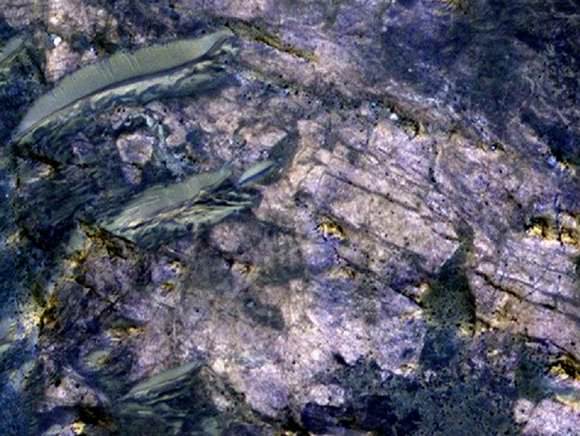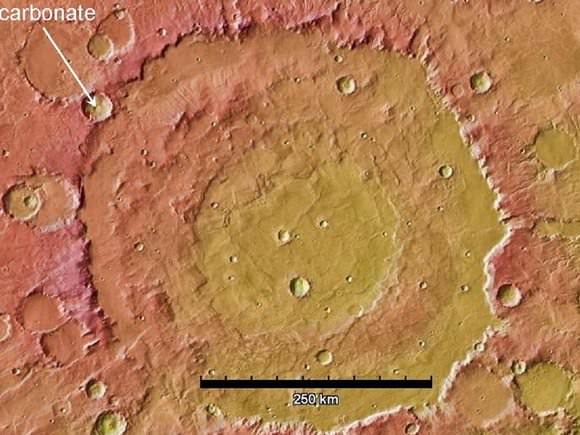[/caption]
A close look at the Wisconsin-sized Huygens Crater, above, in Mars’ southern highlands gave NASA and Arizona State University scientists some clues to announce this week as to a possible source of the carbon that’s mysteriously missing from the red planet’s thin atmosphere.
It might be buried underground.
The impact that formed the crater lifted material from far underground and piled some of it at the crater’s rim, where, at about 10 o’clock on the photo, an unnamed crater later exposed rocks containing carbonate minerals. The minerals were identified by observations with the mineral-mapping Compact Reconnaissance Imaging Spectrometer for Mars (CRISM) on NASA’s Mars Reconnaissance Orbiter.
Carbon dioxide makes up nearly all of today’s Martian air and likely was most of a thicker early atmosphere, too. In today’s thin, cold atmosphere, liquid water quickly freezes or boils away.
Carbonates found in rocks elsewhere on Mars, from orbit and by NASA’s Spirit rover, are rich in magnesium. Those could form from reactions of volcanic deposits with moisture, said James Wray of Cornell University in Ithaca, N.Y. “The broader compositional range we’re seeing that includes iron-rich and calcium-rich carbonates couldn’t form as easily from just a little bit of water reacting with igneous rocks. Calcium carbonate is what you typically find on Earth’s ocean and lake floors.”
He said the carbonates at Huygens and Leighton “fit what would be expected from atmospheric carbon dioxide interacting with ancient bodies of water on Mars.” Key additional evidence would be to find similar deposits in other Martian regions. A hunting guide for that search is the CRISM low-resolution mapping, which has covered about three-fourths of the planet and revealed clay-mineral deposits at thousands of locations.
“A dramatic change in atmospheric density remains one of the most intriguing possibilities about early Mars,” added Mars Reconnaissance Orbiter Project Scientist Richard Zurek, of NASA’s Jet Propulsion Laboratory in Pasadena, Calif. “Increasing evidence for liquid water on the surface of ancient Mars for extended periods continues to suggest that the atmosphere used to be much thicker.”

The HiRISE image above covers an area about 460 meters (1,500 feet) across in which carbonate minerals have been identified. It combines information collected separately in red, blue-green, and near-infrared wavelengths. It’s from HiRISE observation ESP_012897_168, made on April 27, 2009, and centered at 11.6 degrees south latitude, 51.9 degrees east longitude.
“We’re looking at a pretty lucky location in terms of exposing something that was deep beneath the surface,” Wray said. He reported the latest carbonate findings on Tuesday at the Lunar and Planetary Science Conference near Houston.
Observations in CRISM’s high-resolution mode show spectral characteristics of calcium or iron carbonate at this site. Detections of clay minerals in lower-resolution mapping mode by CRISM had prompted closer examination with the spectrometer, and the carbonates are found near the clay minerals. Both types of minerals typically form in wet environments.
The occurrence of this type of carbonate in association with the largest impact features suggests that it was buried by a few kilometers (or miles) of younger rocks, possibly including volcanic flows and fragmented material ejected from other, nearby impacts.
The new findings reinforce a report by other researchers five months ago identifying the same types of carbonate and clay minerals from CRISM observation of a site about 1,000 kilometers (600 miles) away. At that site, a meteor impact has exposed rocks from deep underground, inside Leighton crater. In their report of that discovery, Joseph Michalski of the Planetary Science Institute in Tucson, Ariz., and Paul Niles of NASA Johnson Space Center in Houston, proposed that the carbonates at Leighton “might be only a small part of a much more extensive ancient sedimentary record that has been buried by volcanic resurfacing and impact ejecta.”
NASA will launch the Mars Atmosphere and Volatile Evolution Mission (MAVEN) in 2013 to investigate processes that could have stripped the gas from the top of the atmosphere into interplanetary space. Meanwhile, CRISM and other instruments now in orbit continue to look for evidence that some of the carbon dioxide in that ancient atmosphere was removed, in the presence of liquid water, by formation of carbonate minerals now buried far beneath the present surface.
Source: NASA news release. See also NASA’s Mars Reconnaissance Orbiter page.


Yes! I remember the Leighton find (and incidentally how it taught me the scale depth of crater upcast) and the prediction that came out of it, so I’m very glad it was re-tested.
Incidentally, the LPSC has some interesting results on Venus mineralogy that ties into earlier climate regimes. The results on the old and unique terrain of tessera shows that it is consistent and most easily explained by granites.
Now, AFAIU you can do granites, essentially a convergent minimum of a crust material eutectic without water and the repeated water mixing that plate tectonics bring. (If an eutectic is around, it is the stable ultimate composition some of the material will tend to.) But it will be rare. Tessera is a major component of Venus crust (perhaps 20 % or more IIRC), so if granite it most likely points to an alluring touch stone [sic!] with Earth geo-processes.
AFAIU the granite prediction cover the observed differential signatures naturally through is composition range, click through the links to the presentation ref. The alternative predictions are either differential weathering of mafic rocks, sediments or metamorphic rocks, all of which directly or indirectly points to a different early climate regime. (Most likely a water cycle, it looks to me, though I assume an aeolian regime can’t be ruled out.)
So, going out on a limb and making a layman interpretation to boot, the case for early Venus being like early Earth strengthens, from possibility of water to possibility of plate tectonics.
Dolomites, who seems to be tied to biological processes (Wikipedia).
FWIW, Hazen went through what I experienced as an update on his mineral evolution description during his Linné lecture last month in Uppsala*. The theory now covers many phases, from the ten score or so minerals that can aggregate in interstellar dust, to the perhaps hundreds that evolve in interplanetary disks including impact processes, to the few hundreds that evolve in differentiated bodies, and so on.
At the Mars water history stage you can expect ~ 1 500 minerals. The subsequent explosion of minerals that anaerobic and later aerobic life contribute on Earth was now upped (I think) to 2/3 of the total (~ 4 500, I believe)! IIRC Hazen would like to see some deep Mars mineral samples like the ones described here…
* The real treasure in my mind was the tidbits on the processing of the last release of Kepler data mentioned during the accompanying Celsius lecture. Those will knock your socks off re habitability! Unfortunately there hasn’t been any relevant UT thread to discuss this in. [/sulks]
Much of the carbon on Earth is similarly buried in dolomite and sedimentary rock.
LC
What have any of these ‘posts’ by aggarwalaanil to do with the article?
Absolutely nothing, which is why they have been removed as spam.
Spammers never miss an opportunity to spread their garbage!
Thank you, Ma’am!